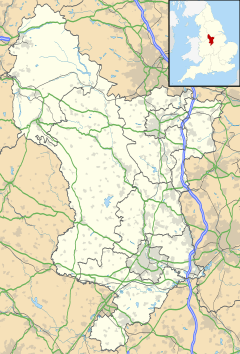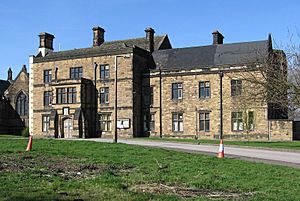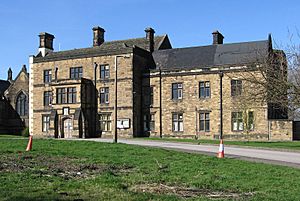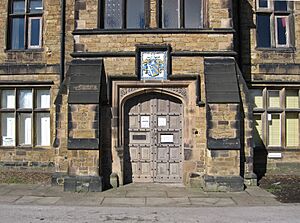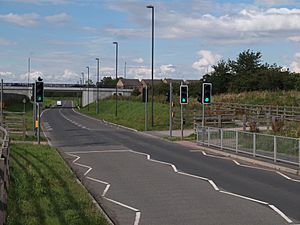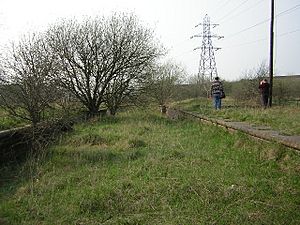Staveley, Derbyshire facts for kids
Quick facts for kids Staveley |
|
|---|---|
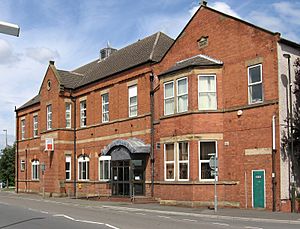 Staveley Miners' Welfare |
|
| Population | 18,247 (including Barrow Hill, Beighton Fields, Mastin Moor and Poolsbrook, civil parish, 2011) |
| OS grid reference | SK434749 |
| District |
|
| Shire county | |
| Region | |
| Country | England |
| Sovereign state | United Kingdom |
| Post town | CHESTERFIELD |
| Postcode district | S43 |
| Dialling code | 01246 |
| Police | Derbyshire |
| Fire | Derbyshire |
| Ambulance | East Midlands |
| EU Parliament | East Midlands |
| UK Parliament |
|
Staveley is a town and civil parish in Derbyshire, England. A civil parish is a local government area. Staveley is located along the River Rother. It is about 5 miles northeast of Chesterfield. It is also near Clowne, Bolsover, Worksop, and Sheffield.
Contents
History of Staveley
Staveley was once a big mining town. Many large coal mines were in and around the area. One famous mine was called Ireland Pit. The Ireland Colliery Brass Band is named after this mine. All the mines in the area have now closed down.
The Staveley Miners Welfare building on Market Street was built in 1893. It was first an indoor market hall. Charles Paxton Markham built it and named it Markham Hall. He named it after his father. Charles Markham was very important in growing industries around Staveley.
His company, Markham & Co., later became Staveley Coal and Iron Company. This company owned many businesses. These included ironstone quarries, coal mines, and chemical works. They also had ironworks and an engineering factory. This factory made equipment for mining.
Other big local industries were the Staveley Works foundry and Staveley Chemicals. Many industries across the country have closed. Because of this, Staveley Chemicals and Staveley Works have mostly shut down. Only one part of the chemical plant remains. It makes P-aminophenol, which is used in Paracetamol. This plant was set to close around June 2012. This marked the end of over 100 years of chemical making in Staveley.
Staveley is also home to the Townes Brewery. Today, a factory that makes plastic pipes for Brett Martin plc is here. There was also a factory that made wood wool at Staveley works.
New Roads and Canals
The New Markham Vale Loop Road has been finished. This road helps open up the old Markham coal field areas for new buildings. It connects the town to a new exit (Junction 29A) on the M1 motorway. This new exit opened in July 2008. The European Union helped pay for this road.
The project also rebuilt part of the old Chesterfield Canal. This canal crosses the new road. There is a long-term plan to rebuild the canal all the way from Chesterfield to Kiveton. Sections of the canal near Chesterfield were rebuilt earlier.
The new Staveley Town Basin officially opened on June 30, 2012. This basin is a main part of the plan to rebuild the Chesterfield Canal in Staveley. It helps boats stop safely for short or long times. It also has a slipway, parking, and toilets. There is a large open play area too. This area can be used for big water events and festivals.
A "Solar Pyramid" was planned for the old Markham Colliery site. It was meant to be the world's largest working timepiece. However, this project was cancelled. Near Poolsbrook Country Park, a caravan site for visitors has been built. This brings more people to the country park. The area has many trails for walking and mountain biking. These trails follow old railway lines from the mines.
Staveley Hall
Staveley Hall is located northeast of St John The Baptist Church. You can reach it from the Lowgates traffic island. The Hall you see today was built in 1604. Sir Peter Frecheville (1571-1634), who was a Member of Parliament, built it. Buildings have been on this site for over 700 years.
Here is a short history of the Hall and its owners:
- Hascuit de Musard received the Manor of Staveley after the Norman Conquest in 1066.
- In 1306, the Musard family ended. Ralph de Frecheville became the new Lord.
- The Frechevilles lived in the Hall until 1682. In 1603, King James I made Sir Peter de Frecheville a knight. Sir Peter wanted Staveley Hall to be a grand home for a knight.
- The person who designed Sir Peter de Frecheville's house is not known. It might have been Huntingdon Smithson. He was the architect for the Cavendish family at Bolsover Castle.
- In 1682, the house was sold to the Cavendish family. James Cavendish died in 1751. The Hall and Park then went back to the Duke of Devonshire.
- In 1756, the local church leader, the Rector of Staveley, asked the Duke of Devonshire if his son could live there. After that, a series of church leaders lived in the Hall.
- It stayed a rectory until Staveley Urban District Council bought it in 1967.
- English Heritage named the Hall a listed building (Grade II) in 1974. This means it is a building of special historical interest.
- In 1974, Chesterfield Borough Council took ownership. Later, Staveley Town Council bought it.
Transport
Staveley used to have four railway stations on two different lines.
Old Railway Stations
- Staveley Central was on the Great Central Main Line. It opened in 1892 as "Staveley Town." It was renamed "Staveley Central" in 1950. It closed for passengers in 1964 and for goods in the 1980s. The platforms were still there until the 2000s. A road called "Ireland Close" was built through the site. Only the bridge that carries the road over the old railway remains.
- Staveley Works was also on the old Great Central Main Line. It was the next stop north after Staveley Central. This station served the old Staveley Works. It opened in 1892 and closed in 1963. The platforms are still there, but the land is now empty.
- Barrow Hill was on the Doe Lea branch line. This line went from Chesterfield to Mansfield Woodhouse. It was also on the Old Road line from Chesterfield to Rotherham. The station opened in 1841 as "Staveley." It was renamed "Barrow Hill and Staveley Works" in 1900. Finally, it became "Barrow Hill" in 1951. It closed for passengers in 1954 and for all traffic in 1981. The site was cleared after it closed. The line between Rotherham and Chesterfield still runs through the site. The Doe Lea Branch closed in the 1990s, and the tracks were removed. There have been ideas to reopen the station to serve Staveley.
- Staveley Town was on the old Doe Lea and Clowne branch lines. These lines connected the town to nearby Bolsover and Clowne. The station opened in 1888 as "Netherthorpe." It was renamed "Netherthorpe for Staveley Town" in 1893. Then, it was finally called "Staveley Town" in 1900. The Doe Lea Branch closed for passengers in 1930. The station was used by trains on the Clowne Branch until 1952. The station was taken down. The line was used until the 1990s when the branch lines closed. The site is now a footpath. There have been ideas to use this part of the railway for a possible line from Chesterfield to Rotherham.
Proposed Bypass Road
People have talked about building a bypass road around Staveley and Brimington since 1927. A bypass is a road that goes around a town to help traffic flow better. When the A61 Rother Way was built in the 1980s, a short dual carriageway was made. It went over the River Rother and the Canal. This road was planned to continue north.
The plans for the bypass caused some arguments. This was because crossing the Canal would have split it into five separate ponds. A group of people signed a petition, which stopped the bypass plans. But some digging for the road had already started.
In 2009, the A6192 Ireland Close was built. This road connects Hall Lane to other roads near Poolsbrook and then to Junction 29A.
There is a plan for a "spine road" as part of rebuilding Staveley Works. This road would go from the supermarket roundabout to Hall Lane. However, it is planned to be a slow, single road with many roundabouts. This might cause more traffic jams.
In July 2019, Lee Rowley, who is the Member of Parliament (MP) for North East Derbyshire, got support from the government for a proper Staveley Bypass.
Media
Local news and TV shows come from BBC Yorkshire and ITV Yorkshire. TV signals are received from the Emley Moor TV transmitter and the Chesterfield TV transmitter.
Radio stations include BBC Radio Sheffield, Hits Radio South Yorkshire, and Greatest Hits Radio Yorkshire. Local radio stations that broadcast from Chesterfield are S41 Radio, Elastic FM, Chesterfield Radio, and Spire Radio.
The Derbyshire Times is the weekly local newspaper for the town.
Notable People from Staveley
Many interesting people have connections to Staveley:
- Robert Keyes (born around 1565) was involved in the Gunpowder Plot. He was the son of the Rector of Staveley.
- John Frescheville, 1st Baron Frescheville (1628–1669) was a Member of Parliament. He was also a Justice of the Peace, which means he helped keep law and order.
- William Hallam was the President of the Derbyshire Miners' Association. He worked as the clerk for Staveley Parish Council.
- Francis Rodes was a judge born here. He built Barlborough Hall nearby. He also helped start Netherthorpe School.
- Thomas Rawson Birks (born 1810) was a Professor at Cambridge University.
- William Young (born 1861) was a cricketer.
- Harry (born 1868) and Will Lilley (born 1885) were footballers. They played for Sheffield United.
- Sam Raybould (born 1875) was a striker for Liverpool.
- Nicholas Richard Ainger was a Member of Parliament. He went to Netherthorpe School here. The school was started in 1572 by four important local families: Frecheville, De Rodes, Sitwell, and Cavendish.
- Chris Spedding (born 1944) is a famous rock and roll and jazz guitarist.
- W.M. Hodgkins was an artist and activist.
See also
 In Spanish: Staveley (Derbyshire) para niños
In Spanish: Staveley (Derbyshire) para niños


